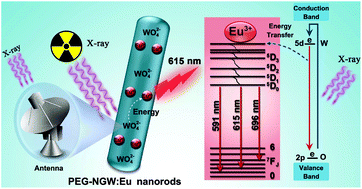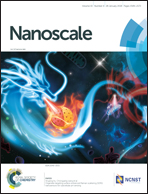High-efficiency X-ray luminescence in Eu3+-activated tungstate nanoprobes for optical imaging through energy transfer sensitization†
Abstract
X-ray luminescence optical imaging has been recognized as a powerful technique for medical diagnosis due to its deep penetration and low auto-fluorescence in tissues. However, the low luminescence efficiency of current X-ray luminescence nanoprobes remains a major hurdle for sensitive bioimaging in practical medical applications. Here we present a new kind of energy transfer-sensitized X-ray luminescence nanoprobe (PEG-NaGd(WO4)2:Eu) for highly effective optical bioimaging. Under X-ray excitation, the tungstate host absorbs the X-ray photons and then transfers the energy to the Eu3+ luminescence center, thus enhancing the luminescence efficiency of the nanoprobes for high sensitivity optical in vivo imaging. Moreover, the shortened T1 relaxation response of Gd3+ ions and X-ray attenuation capability of W atoms enable the nanoprobes to serve as efficient contrast agents for magnetic resonance imaging (MRI) and computed tomography (CT) imaging. Therefore, combined with the MRI, CT and X-ray luminescence imaging capabilities, the present PEG-NaGd(WO4)2:Eu nanoprobes could be used as promising multimodal imaging contrast agents in biological systems.



 Please wait while we load your content...
Please wait while we load your content...